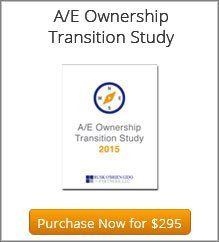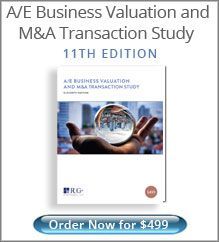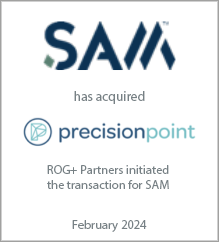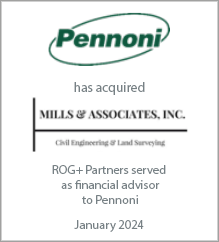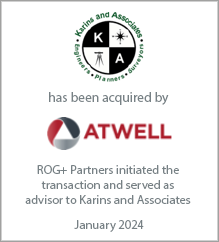Michael S. O'Brien is a principal in the Washington, DC office of Rusk O'Brien Gido + Partners. He specializes in corporate financial advisory services including business valuation, fairness and solvency opinions, mergers and acquisitions, internal ownership transition consulting, ESOPs, and strategic planning. Michael has consulted hundreds of architecture, engineering, environmental and construction companies across the U.S. and abroad.
Ownership Planning: Many Options, But No Magic Bullet
Ownership Planning: Many Options, But No Magic Bullet
February 14, 2011
In our September 2010 ROG + Perspectives, we explained why ownership planning is a requirement for ensuring long-term business success. But have you ever wondered why some companies succeed at ownership transition while others struggle?
The truth is that no single ownership transition plan works for all firms, nor is there any guarantee that a plan that has worked well for a firm in the past will continue to work well in the future. Even within the architecture, engineering and environmental consulting industry, every company has its unique attributes, and those attributes may change over time with new generations of owners. The workplace culture, the employees, the communities in which the firm operates, the services offered, and the financial performance of the company all influence the type of ownership plan that will work best.
In order to develop the right ownership plan for your firm, you need to understand the many options available to your company. These options include:
While there are many options to consider, it’s important also to remember these Three Key Tenets as you develop your company’s plan:
Simplicity – The issues surrounding the transition of ownership in your company may be complex, but the solutions don’t have to be. Simplicity enhances transparency, which in turn fosters trust and confidence—a key to successful transition. Simplicity and transparency should flow through all aspects of your firm’s ownership plan, including how new shareholders are selected, what it means to be a shareholder (i.e., what rights, benefits and responsibilities accrue to shareholders), how shares are valued, when and how shares are redeemed, etc.
Adaptability – Even the best of plans may need to be adapted to reflect changing conditions. All companies evolve over time, increasing or decreasing in size, adding or closing offices, expanding operations into new states or even new countries, making acquisitions, adding new service lines, and more. Such changes sometimes require changes to the firm’s ownership plan. A simple example we often encounter is firms that establish minimum ownership percentage requirements (e.g.,10%) for “principals.” But as the firm grows, the minimum ownership stake becomes more and more expensive relative to the principals’ compensation. In such cases we suggest adapting the plan to establish investment ranges expressed in dollars rather than percentages. Another example is stock redemption terms. Stock redemption terms that may have been feasible when the firm was small and the stock less valuable (e.g., a retiring shareholder’s stock will be repurchased by the company in full with a 20% cash down payment and the remainder in a 3-year note) may be difficult if not impossible to honor based on the firm’s current value. A good plan will allow more discretion and flexibility so that a firm can responsibly manage its obligations.
Internal Consistency – Your ownership plan needs to be consistent with your company’s culture. For example, a firm with an open-book culture and participative management might lend itself well to broadly distributed ownership, and could even be a candidate for an employee stock ownership plan (ESOP). A firm with a history of family ownership, or one with a strict management hierarchy and a “need to know” culture with respect to financial performance data will not lend itself well to broadly distributed ownership. The concept of internal consistency also applies to a firm’s ownership distribution policy. For example, a firm with aggressive growth goals will need to reinvest its profits in itself to support that growth. Its ownership plan should acknowledge this and shareholders should expect to receive less of their return on investment in the form of current returns (dividends, bonuses and s-distributions) and more in the form of long-term capital appreciation.
Developing the right plan for your firm can be a daunting task. The tools and tactics highlighted above all have their strengths and limitations. The principals at Rusk O’Brien Gido + Partners have more than four decades of combined experience working with companies in the A/E and environmental consulting industry to develop comprehensive ownership plans. Our approach to ownership transition planning takes into consideration the needs of all the key constituents –current (selling) shareholders, future (buying) shareholders, and most importantly, the company itself. We consider all available tools and options with the goal of ensuring the long-term success of your company.
The truth is that no single ownership transition plan works for all firms, nor is there any guarantee that a plan that has worked well for a firm in the past will continue to work well in the future. Even within the architecture, engineering and environmental consulting industry, every company has its unique attributes, and those attributes may change over time with new generations of owners. The workplace culture, the employees, the communities in which the firm operates, the services offered, and the financial performance of the company all influence the type of ownership plan that will work best.
In order to develop the right ownership plan for your firm, you need to understand the many options available to your company. These options include:
- Direct Stock Purchase – This is the most common method of transitioning ownership. It usually includes company-assisted financing. Buyers of shares are matched with sellers of shares to mitigate the company’s cash flow obligation for redeeming shares.
- Employee Stock Purchase Plan (ESPP) – This is a simple savings plan whereby employees set aside an equal amount of funds from their paycheck into a “savings account” managed by the company. At the end of the year the employee may elect, at their discretion, to purchase shares of the company.
- Employee Stock Ownership Plan (ESOP) – This is a qualified retirement savings plan that offers tax benefits to the company and plan participants. An ESOP is most often used to redeem large blocks of stock—often 30% or more of the total shares outstanding—from a retiring shareholder. More than any other form of ownership, ESOPs work best in firms that have inclusive and participative management.
- Stock Bonus Plan – Under this plan, instead of using just cash, companies will opt to pay bonuses in the form of stock, or a combination of cash and stock. The company enjoys a tax deduction for using stock, while at the same time conserving cash. This method works with firms whose employees truly value (and understand) the benefits of stock bonuses and recognize that they have actually “paid” for these shares through the deferral of bonuses.
- Synthetic Equity – This term is used to describe both Stock Appreciation Rights and Phantom Stock. Synthetic equity is often used to grant the economic value of ownership to employees who would otherwise be restricted from owning stock due to state licensing requirements or other restrictions. One question to ask before considering synthetic equity is how such instruments will be received by the recipients.
- Stock Options – This is an equity incentive compensation plan that gives the recipient a right to purchase stock at a pre-determined price at some point in the future. This allows the employee to acquire shares at less than the prevailing stock price at the time of exercising the option.
While there are many options to consider, it’s important also to remember these Three Key Tenets as you develop your company’s plan:
Simplicity – The issues surrounding the transition of ownership in your company may be complex, but the solutions don’t have to be. Simplicity enhances transparency, which in turn fosters trust and confidence—a key to successful transition. Simplicity and transparency should flow through all aspects of your firm’s ownership plan, including how new shareholders are selected, what it means to be a shareholder (i.e., what rights, benefits and responsibilities accrue to shareholders), how shares are valued, when and how shares are redeemed, etc.
Adaptability – Even the best of plans may need to be adapted to reflect changing conditions. All companies evolve over time, increasing or decreasing in size, adding or closing offices, expanding operations into new states or even new countries, making acquisitions, adding new service lines, and more. Such changes sometimes require changes to the firm’s ownership plan. A simple example we often encounter is firms that establish minimum ownership percentage requirements (e.g.,10%) for “principals.” But as the firm grows, the minimum ownership stake becomes more and more expensive relative to the principals’ compensation. In such cases we suggest adapting the plan to establish investment ranges expressed in dollars rather than percentages. Another example is stock redemption terms. Stock redemption terms that may have been feasible when the firm was small and the stock less valuable (e.g., a retiring shareholder’s stock will be repurchased by the company in full with a 20% cash down payment and the remainder in a 3-year note) may be difficult if not impossible to honor based on the firm’s current value. A good plan will allow more discretion and flexibility so that a firm can responsibly manage its obligations.
Internal Consistency – Your ownership plan needs to be consistent with your company’s culture. For example, a firm with an open-book culture and participative management might lend itself well to broadly distributed ownership, and could even be a candidate for an employee stock ownership plan (ESOP). A firm with a history of family ownership, or one with a strict management hierarchy and a “need to know” culture with respect to financial performance data will not lend itself well to broadly distributed ownership. The concept of internal consistency also applies to a firm’s ownership distribution policy. For example, a firm with aggressive growth goals will need to reinvest its profits in itself to support that growth. Its ownership plan should acknowledge this and shareholders should expect to receive less of their return on investment in the form of current returns (dividends, bonuses and s-distributions) and more in the form of long-term capital appreciation.
Developing the right plan for your firm can be a daunting task. The tools and tactics highlighted above all have their strengths and limitations. The principals at Rusk O’Brien Gido + Partners have more than four decades of combined experience working with companies in the A/E and environmental consulting industry to develop comprehensive ownership plans. Our approach to ownership transition planning takes into consideration the needs of all the key constituents –current (selling) shareholders, future (buying) shareholders, and most importantly, the company itself. We consider all available tools and options with the goal of ensuring the long-term success of your company.
Latest Perspective
Perfecting the A/E Exit Strategy – Five Key Factors
An enormous A/E generation that kicked off their careers in the 1980s and subsequently started firms or became owners in the 1990s ...
© 2024
Rusk O'Brien Gido + Partners, LLC
Financial Experts for Architects, Engineers, and Environmental Consulting Firms




